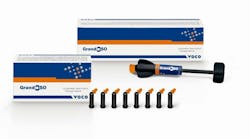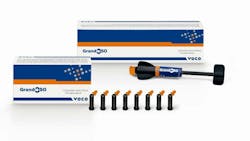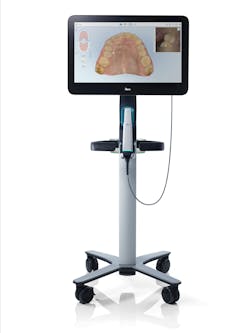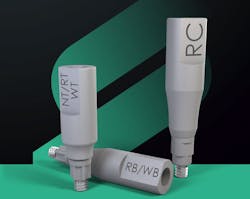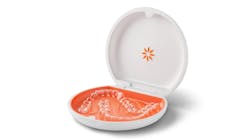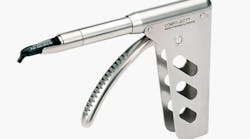Pearls for Your Practice: GrandioSO composite by Voco, iTero Lumina intraoral scanner by Align Technology, and Metal Scanbodies by Straumann
GrandioSO composite by Voco
A day in dental practice is a lot like a day playing golf. I am obviously saying that as someone who does not enjoy golfing! As George Carlin once said, “Golf is a good walk ruined.”
No matter how you feel about the sport, conquering a golf course is a challenge, just like conquering a day of dentistry. In golf, you are limited to 14 clubs in your bag. In dentistry, there is no limit to the number of clubs you can have in your bag … except pragmatism. We need “clubs” that can be used for multiple kinds of “shots.” Finding flexibility in your day-to-day materials is vital to being successful and profitable in your dental practice.
One great choice for a universal restorative material is the GrandioSO line of composites by Voco. It’s like having a golf club you can use for several different kinds of shots!
GrandioSO is a universal nanohybrid composite that can be paired with two different flowable materials to give you the most restorative flexibility possible. The composite comes in both capsules and twist syringes, based on your preference. Personally, I’m a capsule guy.
The composite is 89% filler by weight, giving it excellent strength and wear resistance. It has about 30%–50% less resin compared to classic hybrid composites, meaning it has less polymerization shrinkage (1.6%). It can be used for all classes of restorations in the anterior and posterior. One great feature of GrandioSO is its radiopacity (320%), making it supereasy to see on radiographs.
The flexibility in the GrandioSO line of restoratives comes along with a couple different flowable materials you can either pair with the composite or use on their own. GrandioSO Heavy Flow is a highly viscous flowable composite with 83% nanofiller. It can be used as a base or liner under GrandioSO composite, or it can be used on its own, even in occlusion. Because of its strength, it works well on occlusal surfaces, especially in minimally invasive preparations.
I work hard to keep my preparations small, when possible. Oftentimes, we are rewarded by having narrow preps that are very difficult to fill with pastelike materials. GrandioSO Heavy Flow is great for these areas. It’s strong enough for occlusion while flowing well into the small, narrow prep.
It’s also available in GrandioSO Flow and GrandioSO Light Flow. These are less-filled restoratives that I like to pair with GrandioSO composite. They make great bases and liners for restorations with nooks and crannies that need a little less viscosity to minimize the risk of voids. I tend to avoid using GrandioSO Light Flow and Flow on occlusal surfaces, though GrandioSO Flow is 81% filler.
These materials should all be used in 2 mm increments and light-cured. They can be finished and polished using any composite polishing system. These materials polish well and have great shade consistency over time. Using these materials together basically gives me several different golf clubs in my bag. I can use these materials on virtually every direct restoration in my practice.
Sharp single back up the middle for the GrandioSO family of restoratives!
iTero Lumina intraoral scanner by Align Technology
I was thinking about the first iPhone I ever had and how revolutionary it was. It literally changed my life—and probably yours as well. Of course, the next year, the iPhone 3G came out, and I was superhyped. I grabbed one on release day, and I learned the definition of an incremental upgrade.
The new iPhone was great, but it was only a small step up from the original iPhone. Unfortunately, most new iPhones are incremental upgrades, but occasionally we might get a big advancement like TouchID or FaceID. But most of the time, the "upgrade" is a new color with a camera that’s a little better and a better display. Incremental upgrades.
Digital scanners are like iPhones in our dental practices. Sometimes a new one comes out that is an incremental upgrade. Sometimes we get a much bigger leap. The iTero Lumina scanner is a leap—a huge step forward—and one that’s already changing my practice.
iTero scanners have been around for more than a decade. Starting with the old days of Cadent all the way to Lumina, iTero scanners have been a household name for dentists. Their flexibility and ease of use have made them indispensable for many practices.
The main complaint about the iTero scanners is the size of the wand. The iTero Lumina scanner boasts a wand size that is 50% smaller than any iTero scanner before it. The new wand is both thinner and smaller than its predecessors, which makes it easier and faster to scan, even for small-mouthed or difficult patients. The iTero Lumina scanner has its own disposable sleeve that you’ll need to stock, which costs about the same per use as previous iterations.
Besides offering a smaller wand and a more comfortable scanning experience for your patients, the iTero Lumina scanner is also significantly faster than previous versions. Most scanners on the market use confocal imaging technology to capture a scan. The unit takes in a single image at a time and processes it. iTero Lumina’s Multi-Direct Capture technology utilizes six cameras to capture images simultaneously and process. This makes the scanning process significantly faster.
After a training and adjustment period, my team is now routinely capturing full-mouth scans in less than two minutes—it’s remarkable. Soft tissue is much easier to scan as well. I recently had to scan an edentulous arch, and I got it done in less than three minutes total. That is mind-blowing speed. As I see it, this makes the primary use for the iTero scanner much simpler.
For my practice, the scanner is best used in the hygiene room to communicate treatment needs with our patients. We have routinely used our iTero scanners in the hygiene room with both new and recall patients for years. When I talk to other dentists about this, they always say they don’t have time. Not anymore. Everyone has two minutes during a hygiene visit to grab a quick -iTero Lumina scan and use it to talk with the patient. The new scanner has invalidated the excuse of “not enough time.”
The photorealism of the scanner is second to none; the scans look like intraoral photos. When judged side by side with scans from the iTero 5D Plus scanner, there is a night-and-day difference in clarity and realism. This is great for lab and patient communication.
As of June 2024, the ITero Lumina scanner will be used for orthodontics and patient communication only. Align Technology is expecting FDA approval for restorative and caries detection workflows later in 2024. These should become available with an easy software update.
Right now, we use our iTero Lumina scanner in the hygiene room and for Invisalign scans. Once the new workflows are added, we can use it in any room in the practice. If you have yet to see or try the iTero Lumina scanner, I recommend talking to your Align territory manager about a demo. Once you try it, you won’t want to practice without it!
Three-run home run for Align and the iTero Lumina scanner!
Metal Scanbodies by Straumann
Recently, I was in the Apple Store for a new iPhone case. While I was there, I saw they were doing demonstrations of the Apple Vision Plus. I sat down for a demo of this new “spatial computing” machine and was totally immersed in a new world. The demo was awesome. It was like entering an entirely new computerized world. I was particularly taken by the thought of watching movies on the Apple Vision Plus and bought it on the spot. I’ve been playing around with it a fair amount, and it's superfun—it just isn’t superpractical yet. It needs a few more upgrades to make it more reasonable and practical to use for more than just entertainment.
This is similar to implant digital workflows. Certainly, we have had the ability to digitize our implant workflows. One aspect of the workflows was pretty impractical though, and it remains impractical with several implant systems. Thankfully, Straumann has stepped up to the plate and made digital implant workflows more practical with their new metal scanbodies.
Scanbodies attach to implants to allow us to digitize and communicate to the lab where the implant platform is in relation to the surrounding tooth and periodontium. The laboratory uses design software to line up the scanbody on our scan and extrapolate where the implant is so a restoration can be designed. The two most important parts of using a scanbody are using the correct one and making sure it is fully seated on the implant.
The first generations of these scanbodies were impractical for both. First, they were (and, with many implant companies, still are) made of radiolucent plastic. Taking a radiograph yielded very little information about whether they were seated on the implant. It took experience (and maybe some guesswork on the clinician’s part) to know for sure that the scanbody was seated before the scan was done. If the scanbody was not correctly seated, the restoration would be off for sure. Catastrophic. The idea that a part that must verified with a radiograph could be made from a radiopaque material blew my mind. This was as impractical as it could get.
With Straumann’s new metal scanbodies, I can easily tell if the implant is seated. This is such a welcome change from the plastic scanbody world! I wish every implant company would do this. The new Straumann metal scanbodies have a mattelike finish, which makes them easier to scan. Many of the plastic-type scanbodies are very glossy, so sometimes it’s hard to get a good digital capture. But that’s no longer a problem.
The other nice feature of these metal scanbodies is that they can be autoclaved and used up to 100 times! From a value perspective, that is amazing. No longer do we need to invest $50–$120 on implant impression copings and analogs for every single case. With just a couple of scanbodies, you should be good for hundreds of implant restorations.
Another nice touch is how easy it is to tell which implant these scanbodies are for. There is no color-coding or small print. The size is emblazoned in large letters on the scanbody. Straumann makes the new metal scanbodies in sizes RC, NC, SC, RB, WB, NNC, RN, WN, ND, RT, and WT. That covers the vast majority of the Straumann catalog, with the bonus of knowing you’re using on-brand parts from the company that made the implant. That kind of assurance is priceless in my practice.
Triple to left center field for Straumann. Thank you for making my implant practice more practical!
Editor's note: This article appeared in the June 2024 print edition of Dental Economics magazine. Dentists in North America are eligible for a complimentary print subscription. Sign up here.
